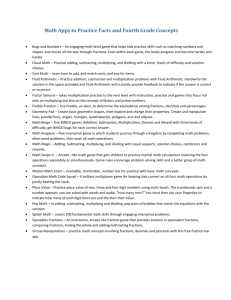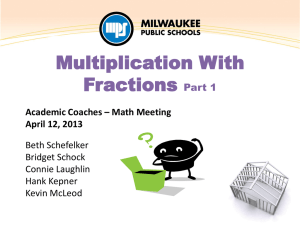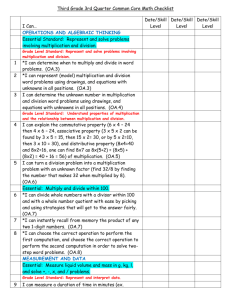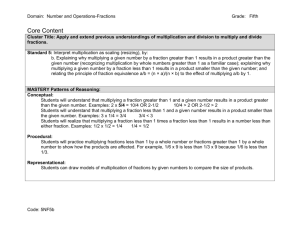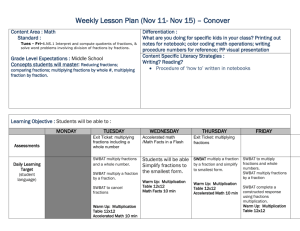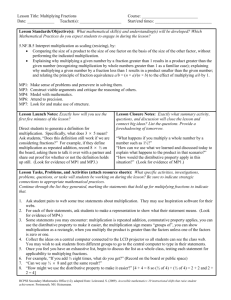Inquiry Math-Multiplying Fractions by Whole Numbers_0
advertisement
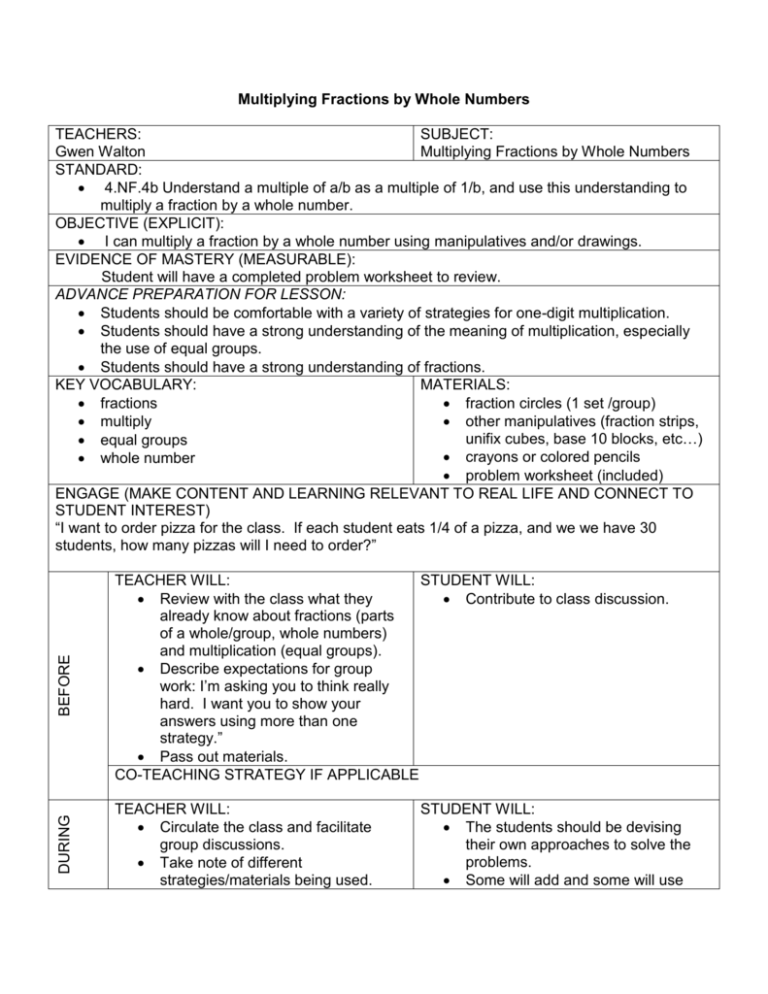
Multiplying Fractions by Whole Numbers BEFORE TEACHER WILL: STUDENT WILL: Review with the class what they Contribute to class discussion. already know about fractions (parts of a whole/group, whole numbers) and multiplication (equal groups). Describe expectations for group work: I’m asking you to think really hard. I want you to show your answers using more than one strategy.” Pass out materials. CO-TEACHING STRATEGY IF APPLICABLE DURING TEACHERS: SUBJECT: Gwen Walton Multiplying Fractions by Whole Numbers STANDARD: 4.NF.4b Understand a multiple of a/b as a multiple of 1/b, and use this understanding to multiply a fraction by a whole number. OBJECTIVE (EXPLICIT): I can multiply a fraction by a whole number using manipulatives and/or drawings. EVIDENCE OF MASTERY (MEASURABLE): Student will have a completed problem worksheet to review. ADVANCE PREPARATION FOR LESSON: Students should be comfortable with a variety of strategies for one-digit multiplication. Students should have a strong understanding of the meaning of multiplication, especially the use of equal groups. Students should have a strong understanding of fractions. KEY VOCABULARY: MATERIALS: fractions fraction circles (1 set /group) multiply other manipulatives (fraction strips, unifix cubes, base 10 blocks, etc…) equal groups crayons or colored pencils whole number problem worksheet (included) ENGAGE (MAKE CONTENT AND LEARNING RELEVANT TO REAL LIFE AND CONNECT TO STUDENT INTEREST) “I want to order pizza for the class. If each student eats 1/4 of a pizza, and we we have 30 students, how many pizzas will I need to order?” TEACHER WILL: Circulate the class and facilitate group discussions. Take note of different strategies/materials being used. STUDENT WILL: The students should be devising their own approaches to solve the problems. Some will add and some will use AFTER Determine which students you will ask to share. Remember that your goal is to help students develop effective strategies that illustrate the meaning of multiplying fractions. CO-TEACHING STRATEGY IF APPLICABLE concepts of multiplication. Draw their solution. TEACHER WILL: STUDENT WILL: When most groups have finished the Share their strategies with the class problems, invite several to share and a neighbor. their strategies and materials used. Create a written response to the activity in their math journal. Try to examine every type of strategy used in the room. At this point do not share the standard algorithm. To close the lesson, ask students to think about their favorite strategy and/or manipulative used from today. The students could discuss this strategy and why they like it with a partner and/or they could write their response in a journal. CO-TEACHING STRATEGY IF APPLICABLE Sharing Procedure 1. Display the student’s drawing and/or materials. You may use a document camera or have the student copy their work onto the board. 2. Ask the student to explain their reasoning for each step. 3. Ask questions to determine the student’s level of understanding, “Why did you…” 4. Allow the class to ask the student math specific questions about the strategy. 5. To ensure others are listening, have each student explain the strategy to a neighbor. 6. Make any clarifying statements about the strategy. 7. Invite a new student to share a different strategy. 1. The fifth grade class is making volcanoes. 3/8 cup of vinegar is needed for each eruption. How much vinegar will be used if 5 volcanoes are erupted? 2. Sam is baking chocolate chip cookies for the class. The recipe calls for ¾ cup of sugar. He wants to make 3 batches of cookies. How much sugar will he need? 3. Kyra’s family sells fresh squeezed orange juice at a farmer’s market. On Monday, they squeezed 15 bottles of juice. On Wednesday, they squeezed 4/5 the amount of juice they squeezed on Monday. How many bottles of juice did Kyra’s family squeeze on Wednesday?

